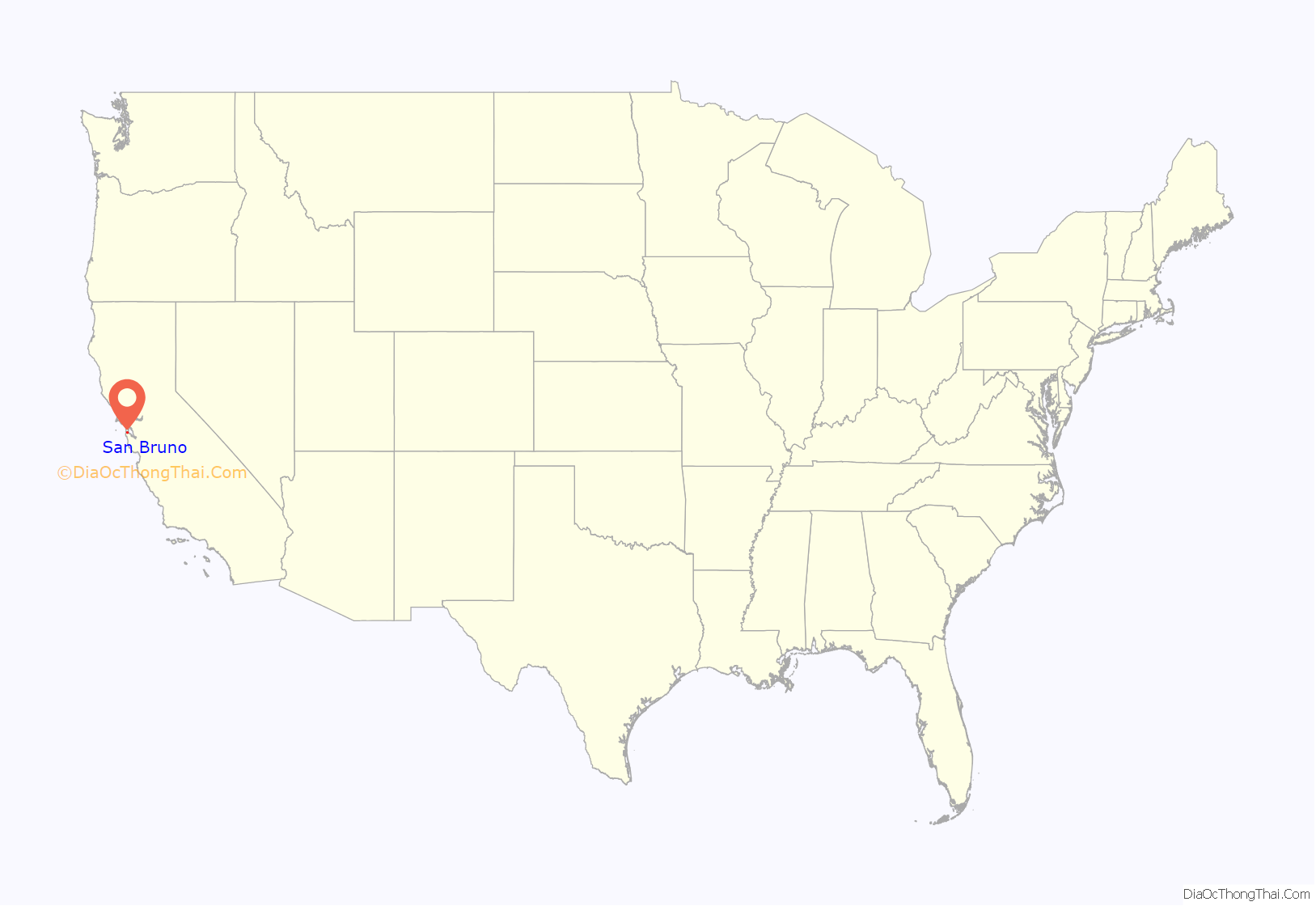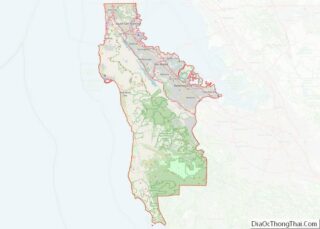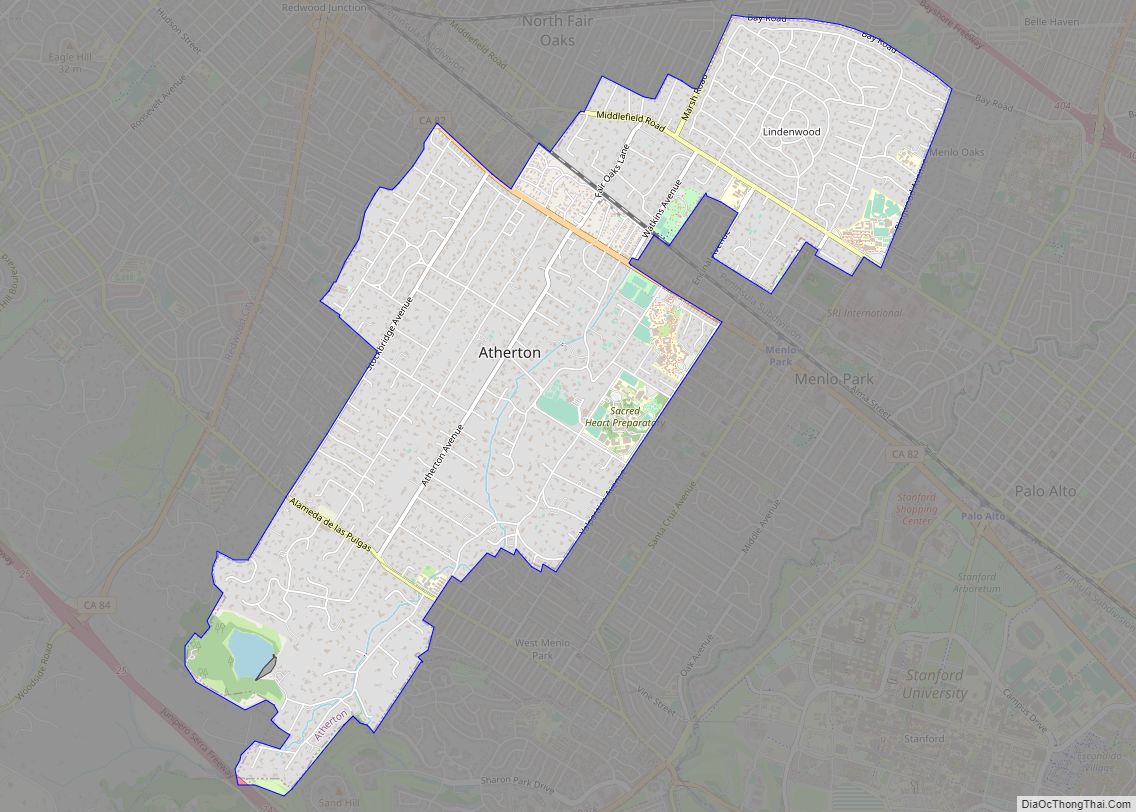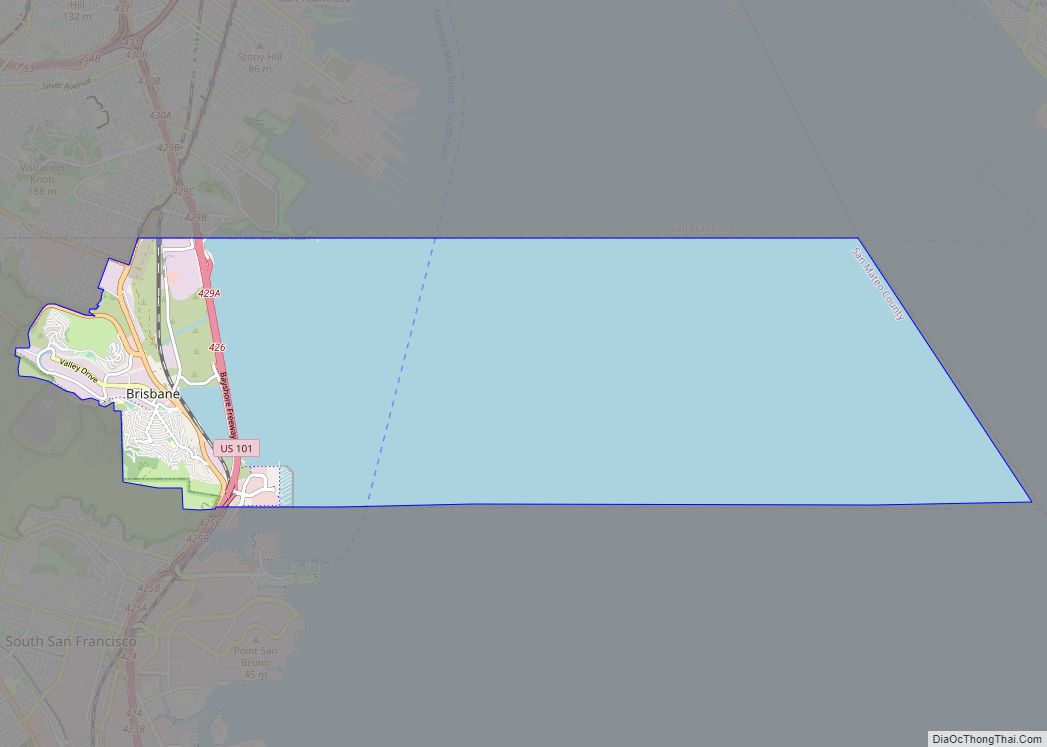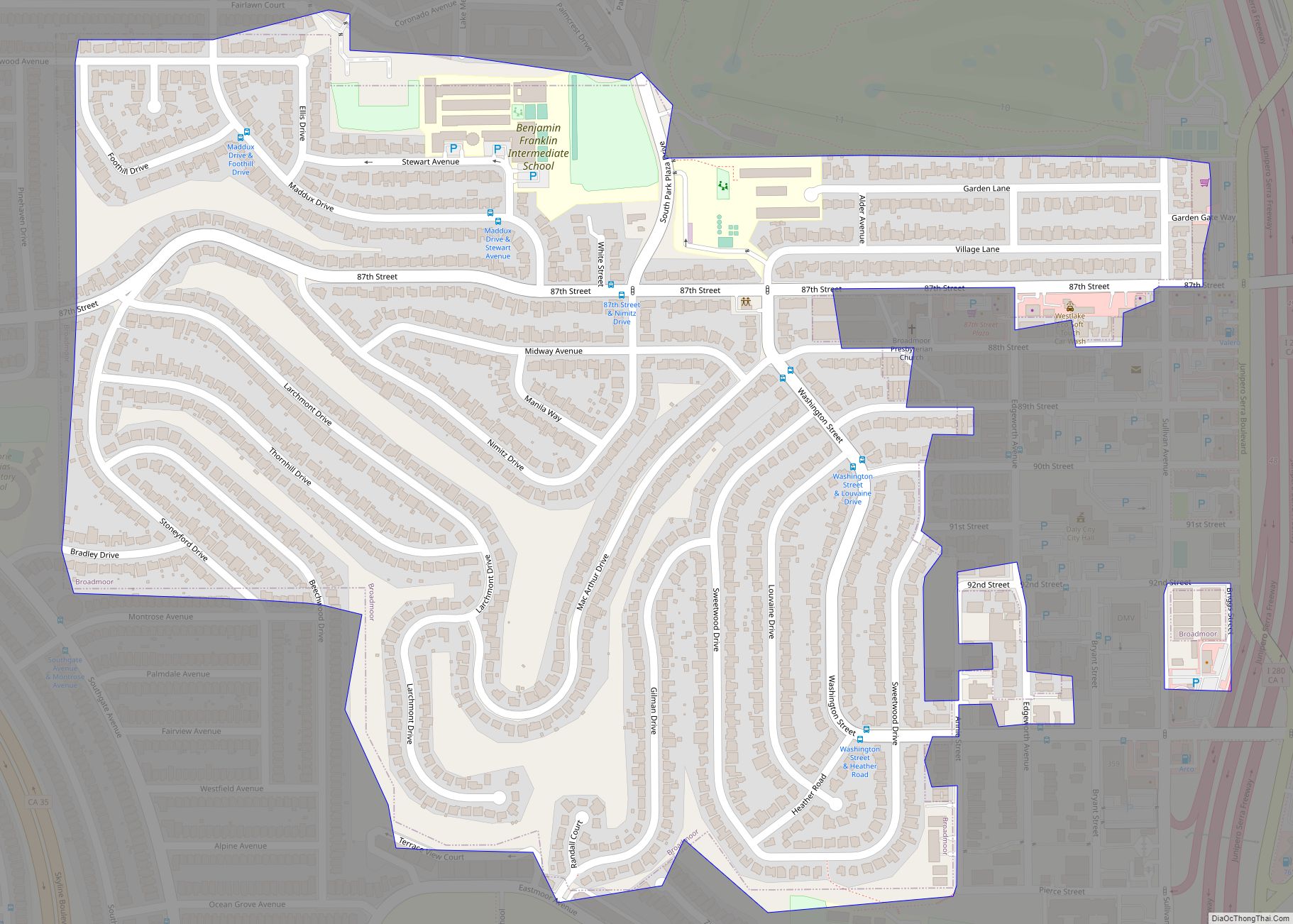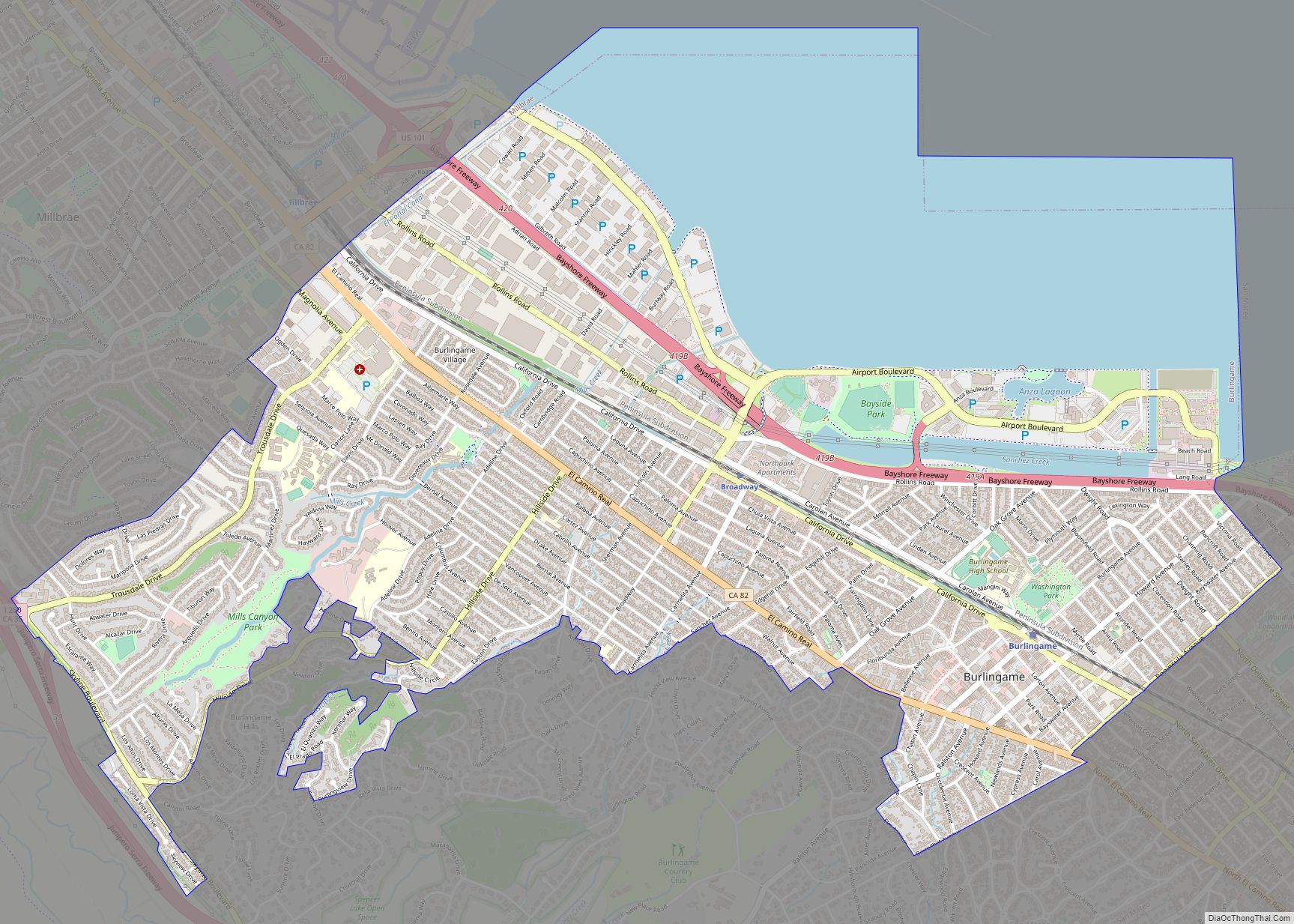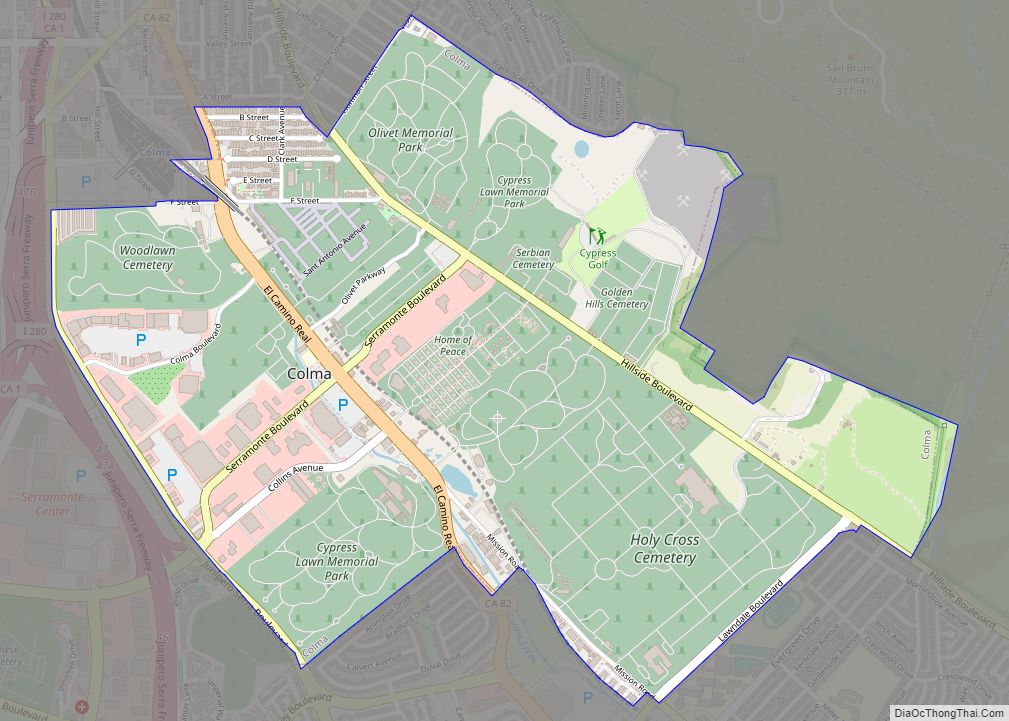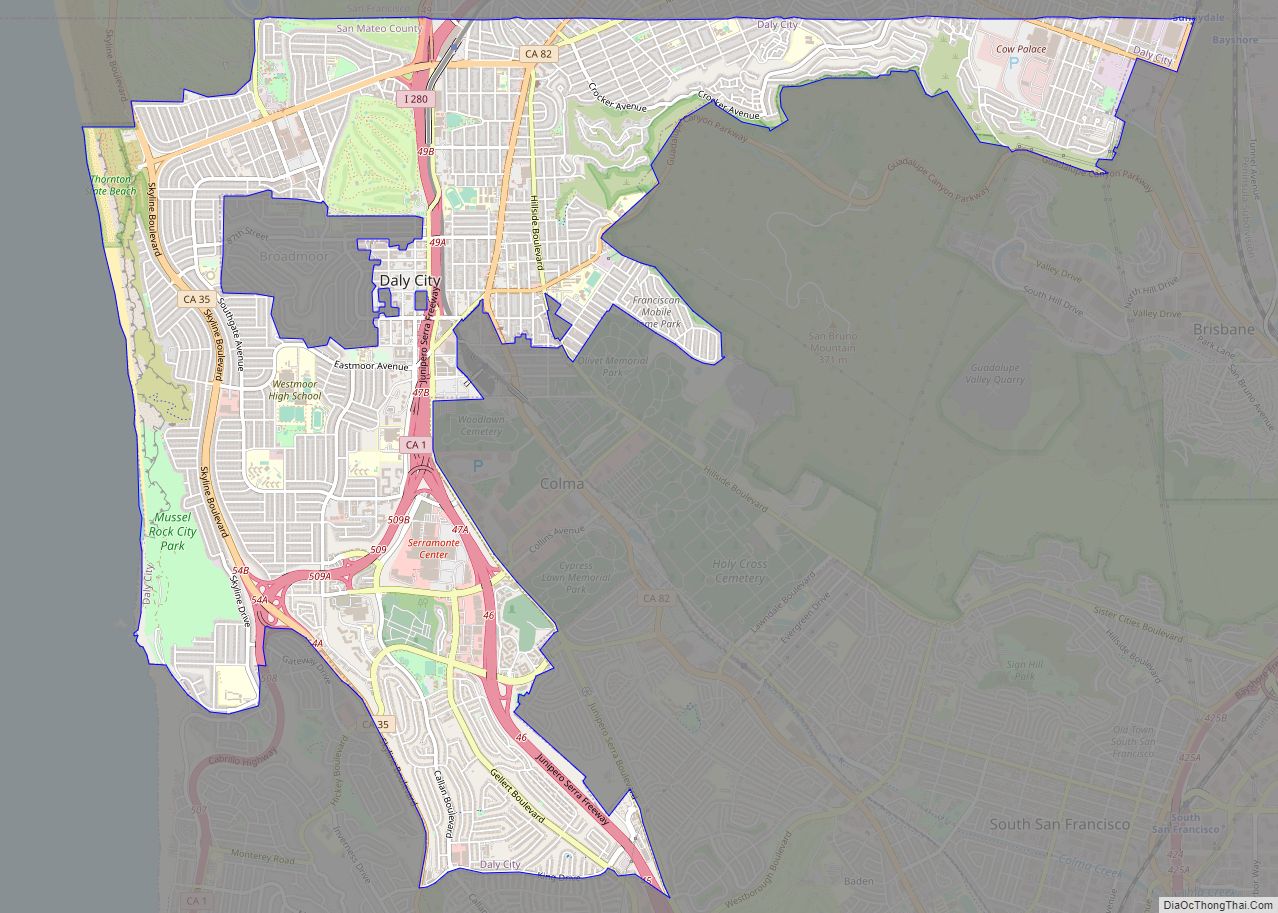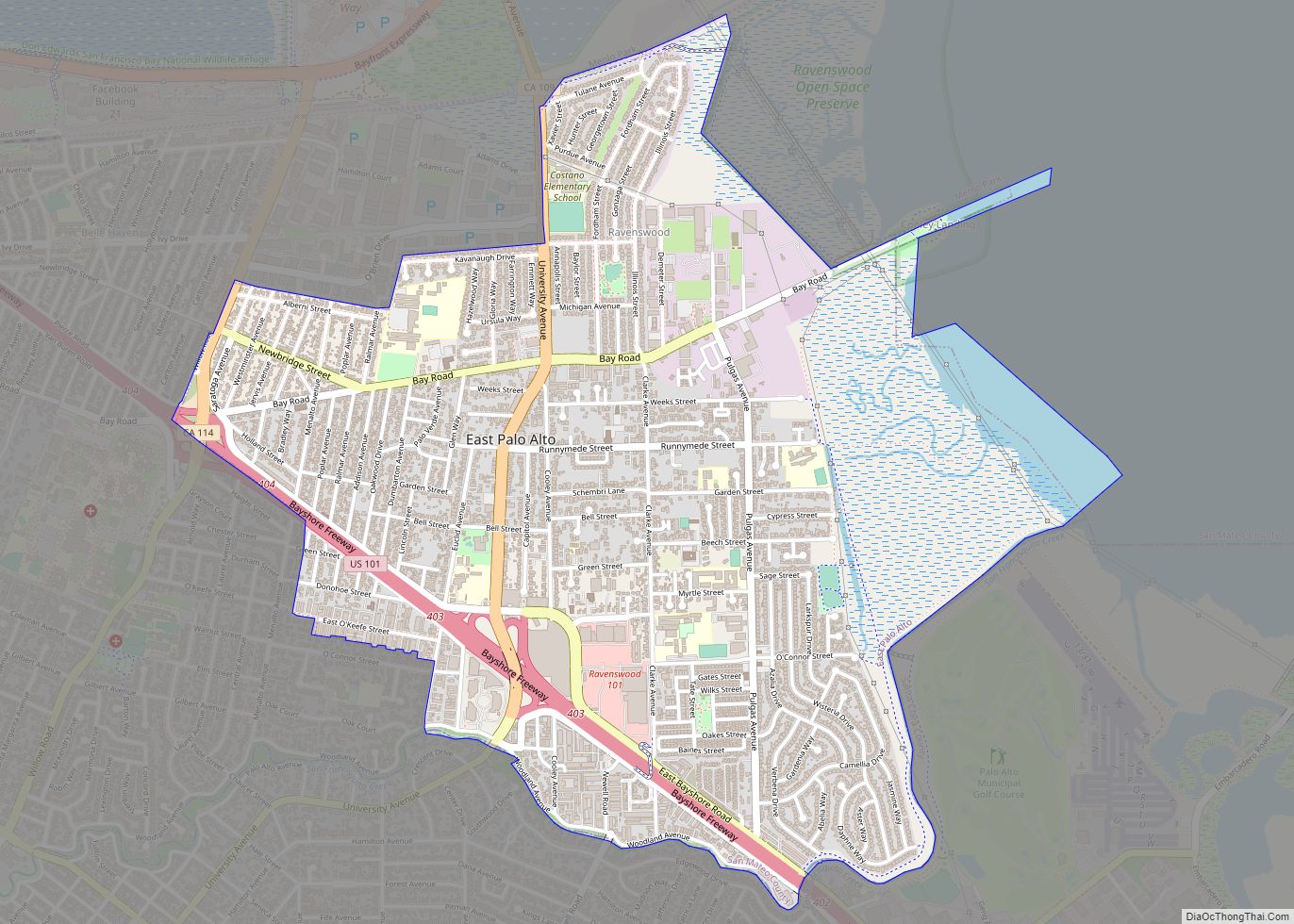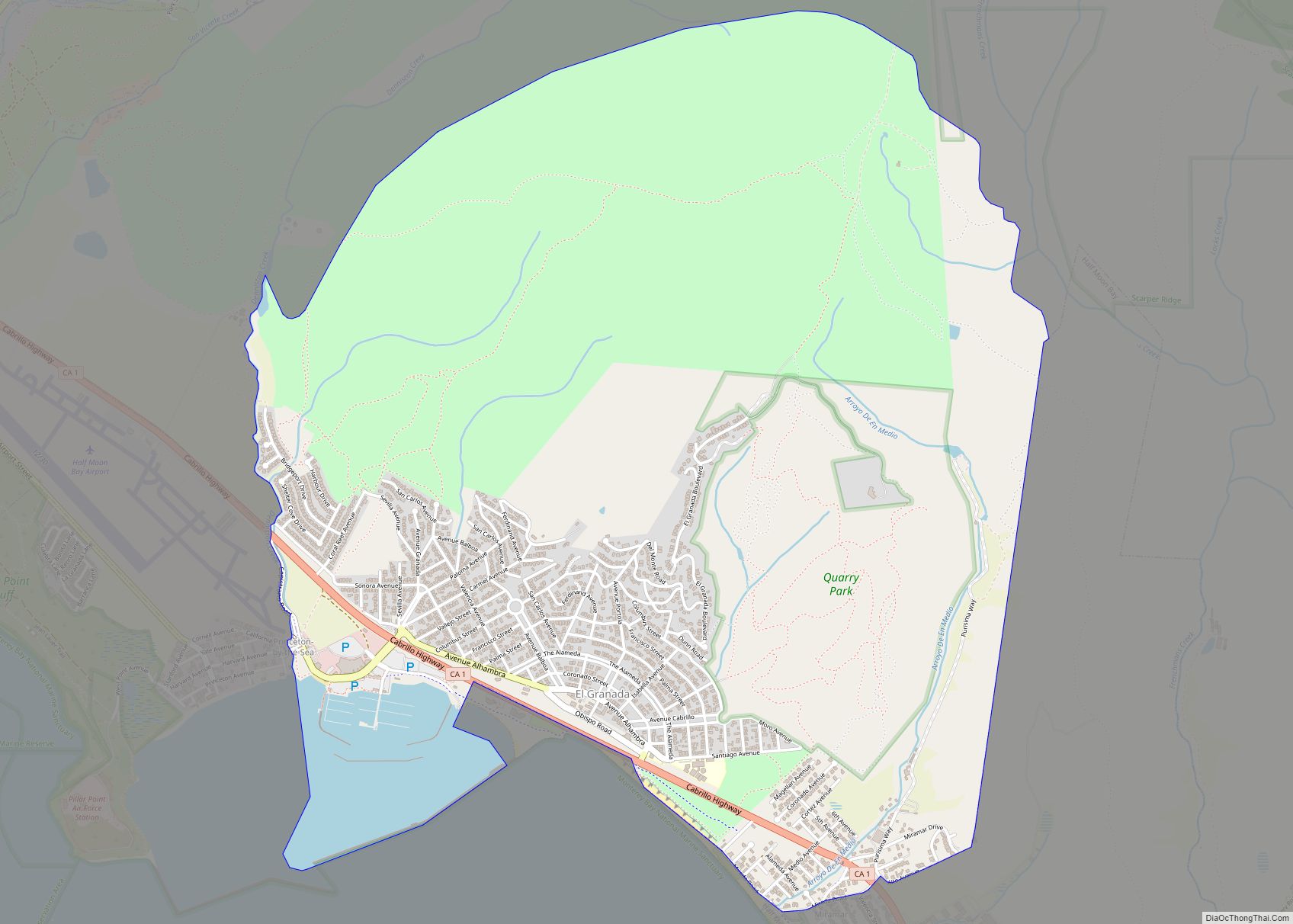San Bruno (Spanish for “St. Bruno”) is a city in San Mateo County, California, United States, incorporated in 1914. The population was 43,908 at the 2020 United States Census. The city is between South San Francisco and Millbrae, adjacent to San Francisco International Airport and Golden Gate National Cemetery; it is approximately 12 miles (19 km) south of Downtown San Francisco.
| Name: | San Bruno city |
|---|---|
| LSAD Code: | 25 |
| LSAD Description: | city (suffix) |
| State: | California |
| County: | San Mateo County |
| Incorporated: | December 23, 1914 |
| Elevation: | 20 ft (6 m) |
| Total Area: | 5.49 sq mi (14.22 km²) |
| Land Area: | 5.49 sq mi (14.22 km²) |
| Water Area: | 0.00 sq mi (0.00 km²) 0% |
| Population Density: | 7,799.2/sq mi (3,011.29/km²) |
| Area code: | 650 |
| FIPS code: | 0665028 |
| Website: | sanbruno.ca.gov |
Online Interactive Map
Click on ![]() to view map in "full screen" mode.
to view map in "full screen" mode.
San Bruno location map. Where is San Bruno city?
History
Early years
San Bruno was the location of the Ohlone village Urebure. It was explored in November 1769 by a Spanish expedition led by Gaspar de Portolà. Later, more extensive explorations by Bruno de Heceta resulted in the naming of San Bruno Creek after St. Bruno of Cologne, the founder of a medieval monastic order. This creek apparently later gave its name to the community.
With the establishment of the San Francisco de Asís (St. Francis of Assisi) mission, much of the area became pasture for the mission livestock. Following the decline of the missions, the area became part of Rancho Buri Buri granted to José de la Cruz Sánchez, the eleventh Alcalde (mayor) of San Francisco. After Jose Antonio Sanchez died, his heirs divided the Rancho and sold it off. Dairy farms later became common in much of the area.
The city began as Clarks’s Station, a stop on the Butterfield Overland Mail stagecoach route, utilizing an inn built in 1849, which was initially called Thorp’s Place and later Uncle Tom’s Cabin or 14 Mile House. The inn was demolished in 1949 and replaced with a Lucky’s supermarket (now a Walgreens drugstore, on the corner of El Camino Real and Crystal Springs Avenue). Gus Jenevein (for whom Jenevein Avenue was named) built another landmark called San Bruno House, which burned several times and was not rebuilt after the third fire. A few homes and farms were developed in the area. The railroad between San Francisco and San Jose built a train station at San Bruno in the 1860s. The railroad eventually became part of the Southern Pacific system, which ran both passenger and freight trains on the line. Today it is known as Caltrain.
A U.S. Post Office was first established at San Bruno in 1875. Postal services were discontinued for several months in both 1890 and 1891, then from 1893 to 1898. There has been a post office in San Bruno continuously since 1898. The present post office is located near the Tanforan shopping center.
20th century
Real growth and development began after the 1906 earthquake and fire. The city’s first public school was completed in late 1906. With the construction of Edgemont Elementary School in 1910, all classes were moved there and the original school building became a public facility named Green Hall. Another school, North Brae Elementary School, opened in 1912; among its earliest students was future actor Eddie “Rochester” Anderson. Paving of California’s first state highway, El Camino Real, began in 1912 in front of San Bruno’s Uncle Tom’s Cabin; the highway is now designated as State Route 82. The adjoining San Francisco International Airport opened in early 1927 and included a Weather Bureau station, now operated by the National Weather Service. Charles Lindbergh was an early visitor to the airport, during his national tour following his successful transatlantic flight; unfortunately, his airplane (Spirit of St. Louis) became stuck in the mud.
On January 18, 1911, aviator Eugene Ely made naval aviation history when he took off from Tanforan and made a successful landing on the armored cruiser USS Pennsylvania anchored in San Francisco Bay. This marked the first successful shipboard aircraft landing.
Following a campaign by the local newspaper, the San Bruno Herald, the community was incorporated in 1914, mainly so the streets could be paved. Green Hall became the first city hall. San Bruno grew rapidly, passing 1,500 residents by 1920 and 3,610 residents in 1930. Additional schools, including New Edgemont (later renamed Decima Allen) and Crystal Springs, were built during the 1940s.
In 1930, the El Camino Theater opened at the corner of El Camino Real and San Mateo Avenue. The popular theater, wired for sound, replaced the earlier Melody Theater, which had presented silent films. The El Camino showed double features, cartoons, short comedies, adventure serials, and newsreels during its history, including Saturday matinees and summer Wednesday matinees for children. Normally, films changed every week, but in 1958 Cecil B. DeMille’s The Ten Commandments ran for two weeks to packed audiences. The theater closed in the early 1970s when a four-screen movie theater opened in the Tanforan shopping center. The El Camino Theater building was remodeled, but later demolished. The lot is now home to mixed-use apartment and retail space. A larger, multi-screen complex was later built north of Tanforan, but it has been replaced by an even larger complex, Century at Tanforan, in the remodeled shopping center.
In 1939, the War Department created the Golden Gate National Cemetery in San Bruno as space was starting to run out for veterans to be buried at the Presidio of San Francisco. In 1942, after the start of World War II, the local racetrack became the Tanforan Assembly Center, a temporary detention site for Japanese Americans evicted from the West Coast under Executive Order 9066.
Following World War II, there was continued growth and new subdivisions were built in Mills Park, Rollingwood, and Crestmoor. In 1947, the Bayshore Freeway (U.S. Route 101) was opened from South San Francisco to Redwood City and included an interchange at San Bruno.
Prior to 1950, San Bruno’s high school students attended San Mateo High School (opened in 1902) and then Burlingame High School (opened in 1923), traveling to and from school on the streetcars that ran next to the Southern Pacific railroad. Finally, on September 11, 1950, Capuchino High School opened in San Bruno. After years of using Green Hall as a multi-purpose building, the city dedicated a library and city hall in 1954. That same year saw the dedication of the current central terminal at the airport, part of a major expansion program. A central fire station was later built next to the city hall; an additional station was built in Crestmoor.
Actress and businesswoman Suzanne Somers was born in San Bruno in 1946. She attended local schools and graduated from Capuchino High School in June 1964.
In 1953, San Bruno annexed the adjoining unincorporated community of Lomita Park, bounded by San Felipe Avenue, El Camino Real, San Juan Avenue, and the railroad tracks. Until the annexation, Lomita Park had its own Southern Pacific train station and some community services.
Parkside Intermediate School was opened in 1954, followed by additional elementary schools: Rollingwood, Crestmoor, John Muir, and Carl Sandburg. A second intermediate school, Engvall, was built in Crestmoor Canyon, only to be closed, along with North Brae and Sandburg, when enrollment fell. These were all part of the San Bruno Park School District. Students in northwestern San Bruno were included in the Laguna Salada district. The private school, Highlands Christian School, is also located in San Bruno. Founded in 1966, Highlands Christian School is an interdenominational school, and offers preschool through college preparatory school instruction.
San Bruno considered new annexations in the mid-1950s that would have extended the city limits to the Pacific Ocean. The unincorporated communities west of San Bruno were against annexation, and collectively incorporated as the city of Pacifica in 1957.
On March 22, 1957, a magnitude 5.7 earthquake was centered in the area of the city. It inflicted minor damage throughout the city.
Eitel-McCullough operated a large manufacturing plant in San Bruno for many years. William Eitel and Jack McCullogh formed the company in 1934. It specialized in the manufacture of power grid tubes. Known as Eimac, the company also made vacuum tubes used in communication equipment, as well as other products for military and commercial applications. Due to its work on broadcast transmission parts, Eimac operated an FM radio station, KSBR, which transmitted on 100.5 megahertz. The station began operations in 1947 and, that same year, was one of only two in the nation to test Rangertone tape recorders. (The other station was WASH-FM in Washington, D.C.) The recorders were based on the German Magnetophon. In need of more space, the company moved to San Carlos in 1959. Eimac’s San Carlos plant was dedicated on April 16, 1959. In 1965, Eimac merged with Varian Associates and became known as the Eimac Division. In 1995, Leonard Green & Partners purchased the entire Electron Devices Business from Varian and formed Communications & Power Industries.
Crestmoor High School opened in September 1962, but was closed in June 1980 due to a decline in school enrollment. The city has a two-year community college, Skyline College.
A major landmark in San Bruno for many years was Tanforan Racetrack, which opened in 1899. Such famous racehorses as Seabiscuit and Citation raced there. Famed Hollywood director Frank Capra filmed scenes for two of his films, Broadway Bill and Riding High, at the racetrack. For six months in 1942, it served as one of the main Bay Area centers for those forced into Japanese American internment, processing about 8,000 Japanese before they were sent out to larger facilities in the desert of Utah and Manzanar in Owens Valley. The track closed in 1964 and was about to be demolished when it was destroyed in a major fire on July 31, 1964. The Shops at Tanforan mall was later built on the site; surrounding city streets were named for some of the racehorses who appeared at Tanforan.
The city was the site of the crash of Flying Tiger Line Flight 282 on December 23, 1964.
During the late 1960s, the I-280 (Junipero Serra Freeway), followed by I-380, was built through San Bruno. The San Bruno Planning Commission (then chaired by Peter Weinberger, brother of Caspar Weinberger) reviewed and approved plans for two major shopping centers, Bayhill (located on the old U.S. Navy property between San Bruno Avenue and Sneath Lane) and Tanforan. With final approval from the San Bruno City Council, construction proceeded on these major retail developments. Prior to these developments, most of the city’s retail businesses were located on San Mateo Avenue and El Camino Real.
San Bruno is one of two cities in the Bay Area that manages its own cable TV and internet system.
The October 17, 1989, Loma Prieta earthquake (6.9 magnitude) caused some damage in the city. The U.S. Postal Service’s Western Regional headquarters, which was then the tallest building in San Bruno, had to be demolished due to severe structural damage. The site was rebuilt as part of an expansion of The Gap clothing company world headquarters campus. The building now houses the headquarters for Wal-Mart’s online retail services, Walmart.com, and is now the tallest building in the city.
21st century
The San Bruno BART station opened in 2003, when the transit system was extended to Millbrae and the San Francisco International Airport.
On September 9, 2010, at about 6:15 p.m. PDT, a gas line ruptured leading to a fire that severely damaged a residential neighborhood. Eight people were killed, nearly 60 others were injured, 38 homes were destroyed and 123 additional homes were damaged. The resulting fire “hot spots” were easily detected using meteorological satellite images.
The explosion, which took place two miles (3 km) west of San Francisco International Airport (37°37′23″N 122°26′31″W / 37.623°N 122.442°W / 37.623; -122.442 (September 2010 explosion and fire in San Bruno, California)), was initially thought to have been a plane crash, but the FAA and airport officials confirmed no downed aircraft was reported.
During the days prior to the explosion, some residents reported a strong smell of natural gas in the area.
On September 10, a team from the National Transportation Safety Board began an investigation into the cause of the explosion.
On September 13, PG&E agreed to set aside a $100 million fund to the victims of the explosion. This does not preclude residents from taking any further action against PG&E. Parts of the exploded material were taken to Washington, D.C., a couple of days after the explosion for examination.
In 2007, YouTube had moved its headquarters from San Mateo, California to San Bruno, on Cherry Avenue next to Interstate 380. The main building was initially built for Gap Inc. in 1997. It had been designed in 1994, has a green roof, and was built with energy efficient ventilation systems. Across more than six properties, YouTube has over 2,000 employees working in the city, and is San Bruno’s largest employer. On April 3, 2018, a shooting took place at the headquarters complex, leaving four wounded and the female shooter dead.
During World War II the United States Navy established a base on what was a dairy opened by Richard Sneath. There it operated a Classification Center and a Naval Advance Base Personnel Depot. After the war it continued operation, and became host to the consolidated Western Division of Naval Facilities, supporting the multiple navy bases that were operating in the greater San Francisco Bay Area. Due to the 1993 BRAC and its closure of neighboring bases although recommended for realignment, the Navy decided to close the facility, carrying through with its decision in October 1994.
The federal government retained part of the former Naval Facility. The Pacific Region (San Francisco) facility of the National Archives and Records Administration was established. One of the buildings became a Navy and Marine Corps Reserve Center, which hosts the Headquarters Company of the 23rd Marine Regiment, amongst other units. The rest of the facility was sold to a private developer who has since built multi-story apartment buildings on the former base. The 20-acre (81,000 m) area of the former U.S. Navy complex is bounded by San Bruno Avenue, El Camino Real, Sneath Lane, and I-280.
San Bruno Road Map
San Bruno city Satellite Map
Geography
The city is located between South San Francisco and Millbrae, adjacent to San Francisco International Airport to the east and Golden Gate National Cemetery to the northwest. It is approximately 12 miles (19 km) south of Downtown San Francisco.
According to the United States Census Bureau, the city has a total area of 5.5 square miles (14 km), all of it land. The city spreads from the mostly flat lowlands near San Francisco Bay into the foothills of the Santa Cruz Mountains, which rise to more than 600 feet (180 m) above sea level in Crestmoor and more than 700 feet (210 m) above sea level in Portola Highlands. San Bruno City Hall sits at an official elevation of 41 feet (12.5 m) above sea level.
Portions of Mills Park, Crestmoor, and Rollingwood are very hilly, featuring canyons and ravines. Creeks, many of them now in culverts, flow from springs in the hills toward San Francisco Bay. Just west of Skyline Boulevard and outside of city limits is San Andreas Lake, which got its name from the San Andreas Fault. The lake is one of several reservoirs used by the San Francisco Water Department, providing water to San Francisco and several communities in San Mateo County, including San Bruno west of I-280.
See also
Map of California State and its subdivision:- Alameda
- Alpine
- Amador
- Butte
- Calaveras
- Colusa
- Contra Costa
- Del Norte
- El Dorado
- Fresno
- Glenn
- Humboldt
- Imperial
- Inyo
- Kern
- Kings
- Lake
- Lassen
- Los Angeles
- Madera
- Marin
- Mariposa
- Mendocino
- Merced
- Modoc
- Mono
- Monterey
- Napa
- Nevada
- Orange
- Placer
- Plumas
- Riverside
- Sacramento
- San Benito
- San Bernardino
- San Diego
- San Francisco
- San Joaquin
- San Luis Obispo
- San Mateo
- Santa Barbara
- Santa Clara
- Santa Cruz
- Shasta
- Sierra
- Siskiyou
- Solano
- Sonoma
- Stanislaus
- Sutter
- Tehama
- Trinity
- Tulare
- Tuolumne
- Ventura
- Yolo
- Yuba
- Alabama
- Alaska
- Arizona
- Arkansas
- California
- Colorado
- Connecticut
- Delaware
- District of Columbia
- Florida
- Georgia
- Hawaii
- Idaho
- Illinois
- Indiana
- Iowa
- Kansas
- Kentucky
- Louisiana
- Maine
- Maryland
- Massachusetts
- Michigan
- Minnesota
- Mississippi
- Missouri
- Montana
- Nebraska
- Nevada
- New Hampshire
- New Jersey
- New Mexico
- New York
- North Carolina
- North Dakota
- Ohio
- Oklahoma
- Oregon
- Pennsylvania
- Rhode Island
- South Carolina
- South Dakota
- Tennessee
- Texas
- Utah
- Vermont
- Virginia
- Washington
- West Virginia
- Wisconsin
- Wyoming
